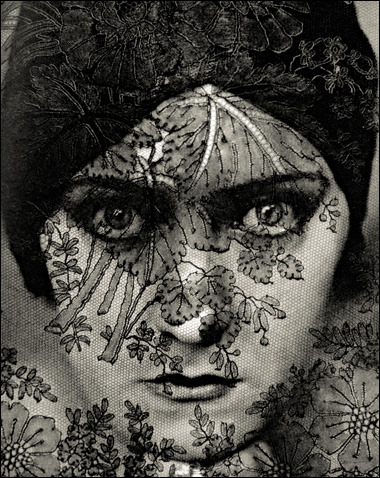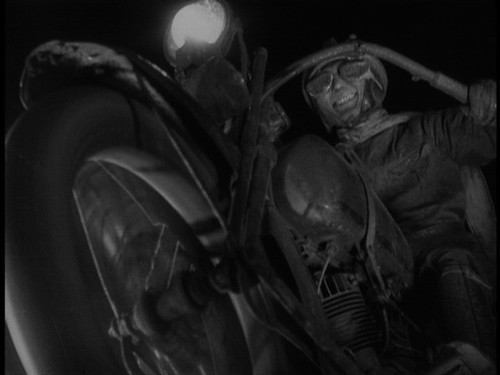
Wednesday, August 24, 2011
I'm Ready For My Close-Up Mr Steichen!
An amazing portrait of Gloria Swanson by Edward Steichen from 1924. The eyes behind the veil are amazing, those of a seer, a prophetess, a hypnotiser of silent movie audiences.


Thursday, August 18, 2011
Clip Joint Round-Up: Voice-Over

I love a good voiceover. It's always annoyed me when people (like Robert McKee) dismiss them as a failure of cinematic storytelling, as if cinema was a pure art form and not a mongrel one made up of all the others, plus that little bit extra, that cinema magic, that alchemy. There are plenty of sloppy voice-overs, of course, but the best add mood, poetry, depth and complication to the cinema experience. I liked this Clip Joint because it laid out, in clip after clip, how essential the voice-over/narration has been to so many great films and filmmakers, how the history and development of the medium would be immeasurably poorer without it. Once again, picking favourites was tough, but I ultimately choose the five below. Steenbeck's well thought-out choices are here below the main article.
It's clear now the theatrical soliloquy was always a frustrated voice-over, the only way dramatists had to let audiences know what characters were thinking. But cinema solved this problem. Now we were inside their minds, their inner voice somehow speaking in our minds, a new form of telepathy. It's one of cinema's great weapons of seduction, the intimacy of that disembodied voice, especially if delivered in the velvet purr of a great actor. Laurence Olivier used it in his Hamlet (1948) to emphasise certain lines in the 'to be or not to be' speech, but couldn't resist the actorly chance to declaim much of it as he would have on stage. It was left to Orson Welles (as it so often was) to fully merge the theatrical with the cinematic in his Shakespeare films, especially Othello (1952) where he seems to have realised the soliloquy was a natural voice-over, that it added that air of brooding self-absorption required for acts of tragic folly.
Noir captured that late '40s mood of existential dread, a generation's collective hangover from the traumas of war, its uneasy awareness of how the forces of history and politics could sweep people away. So if you could die at any minute, if you were merely an expendable pawn in someone else's game, what did anything matter? (This was the seed from which cool was born, of course. Not caring being the essence of it). This fatalism was inextricably linked to the laconic tone of the voice-over. Think of Robert Mitchum in Out Of the Past (1947) watching Jane Greer enter La Mar Azul. 'And then I saw her', he tells us, 'coming out of the sun.' That line's no accident I think. We're in Mexico, Acapulco, home of the Aztecs, whose sun gods demanded human sacrifice as tribute or they'd refuse to move across the sky. So here comes Kathie Moffat, out of the sun, demanding a human sacrifice of her own. And Jeff Bailey is it. He doesn't know it yet but his voice-over does. That's no woman coming towards him in a cool white dress, face hidden in the shadows, it's fate.
As noir prospered and matured it was inevitable that someone would take the genre's fatalism to its logical conclusion. And that someone was Billy Wilder. In Sunset Blvd (1950) his narrator, Joe Gillis, isn't on a trolley-car to the end of the line, he's already there, face down in a Hollywood swimming pool. Listen to the bright, cynical tone of the voice-over, the disembodied voice of Gillis' soul mockingly declaring 'poor dope' to his corporeal self, floating in the water with three bullets in him, press cameras flashing in a grotesque parody of the Hollywood dream of fame. Wilder brilliantly realised the analogous link between noir and fame, both were ritualised traps, and when fame was gone, the living might as well be dead. Norma Desmond's mansion is, after all, little more than a fancy mausoleum, a ghost house where silent movie stars like Mabel Norman and John Gilbert once swam in the pool 'ten thousand midnights ago...' Time is different in Hollywood, stars disappear in the dark, ghosts flicker in projector light and the dead speak to us in voice-over.
Contrary to popular opinion, cinema isn't a visual medium. It's a hybrid one that synthesises all the other art forms into itself. Take this scene from Badlands (1973) where music, words and images work together in perfect harmony. There's even the musical quality in Holly's accent. Her voice-over is like the narration of a girl's book, a story she's telling herself. They're like the Swiss Family Robinson, building underground tunnels and tree houses on a desert island. But the images play off this, like the gun beside Kit as he sleeps. The mood this sequence captures is almost exactly what Holly imagines is happening, an idyll, timeless revery. They've taken two steps to the left and are in an adventure, inventing passwords and watching the clouds go by. Even the casual way she says 'they hadn't found but one set of bones in the ashes of the house' betrays nothing of the fact that those bones belong to her father, murdered by Kit. It's like none of it is real to her, or rather, that reality can't compete with the yearning fantasy set free by the arrival of Kit, that adolescent desire to feel like you're in a book or film. Imagine the feeling if your life started to resemble one? Wouldn't that seem real to you, inevitable, a fulfilment of some kind? Don't we all want to escape the random drift of our lives and enter a world shaped by plot, by the rhythmic certainty of sentences? Aren't we all telling the story of our lives to ourselves in our minds, increasingly disappointed by its refusal to take shape into any recognisable narrative? Holly's voice-over tells us how a girl could end up on a killing spree with a boy she hardly knows. Kit is like a character from a movie who's materialised out of nowhere to take her through the looking glass. Twirling her baton in the Texas dust his appearance has the inevitability of a dream, of a promise foretold.
With Taxi Driver (1976) we're back to noir, to the insularity cities can provoke, the loneliness, to what it sounds like when that loneliness edges towards madness. In other words, welcome to the mind of Travis Bickle. While the loner is a hero of fiction, in the real world, as Philip Larkin once observed, 'virtue is social', and the loner/misfit is generally not liked or trusted. But inside most people there's a yearning for self-reliance, a sneaky admiration for those who refuse to take the daily compromises required to exist in society. 'Hell is other people,' as Sartre said, and we seek the escape of fantasy worlds to release this tension inside us, worlds where men stand alone against a corrupt world. 'Down these mean streets a man must go who is not himself mean,' Raymond Chandler famously wrote, 'who is neither tarnished nor afraid..a man of honor...with...a disgust for sham, and a contempt for pettiness.' That's Travis Bickle, a hero out of time, a social misfit who takes girls to porno movies and talks to himself in mirrors, but who, in a different context, could easily be a hero, a man of honour. It's just his fate to exist in a world where heroism is a myth and honour an anachronism, where loneliness isn't a manly virtue but a slow disease, an inner voice telling you crazy things. Betsy, his would-be heroine, calls him '...partly truth, partly fiction. A walking contradiction,' quoting Kris Kristofferson's song The Pilgrim. (A pilgrim, of course, is someone on a quest for the sacred, like the Pilgrim Fathers, those English Separatists who founded the first American colony. Travis is like one of these puritans, these outsider/outcasts in search of a shining city, finding himself instead in '70s New York, fascinated, disgusted and confused). He writes in his notebook and we hear these thoughts. We could see the words on the page instead, of course, which would make Robert McKee happy, but would, obviously, be stupid. These thoughts are, after all, in his head before they end up on the page. We hear them forming as he rides the night streets, watching New York in its vibrancy and breakdown (possibly the same thing). It's seductive, the poetry of it, 'whores, skunk pussies, buggers, queens, fairies, dopers, junkies', how easily it makes us identify with the confused voice, how righteous it makes his thoughts sound, all that externalised self-hatred passing for moral purity. Good and evil. Salvation and damnation. God's lonely man and the scum of the streets. (How close, by the way, is this scene to the Pottersville sequence in Capra's It's A Wonderful Life. Travis is the right-wing George Bailey, a man who would not take it anymore, who decides to stand up rather than throw himself off a bridge in despair.)
Tuesday, August 9, 2011
Saturday, August 6, 2011
Caligari At The Cathedral

Went to see The Cabinet of Dr Caligari last night in St Canice's Cathedral as part of this year's Kilkenny Arts Festival. The music was provided by my old favourites 3epkano along with organist Eric Sweeney. The 19th century organ is one of the biggest in Europe and looks like it came from The Phantom of the Opera. Most people I spoke to afterwards seemed to think it didn't contribute as much as they were expecting but this is a minor quibble in what was a wonderful experience. The Cathedral was a suitably gothic venue for the screening, the mediaval arches of the alter bathed in flourescent blue, the musicians hidden in the dark behind the screen, everyone sat happily in their pews, worshipping at the high altar of cinema.

The film cast its spell too. Despite some ripe acting it's still remarkably effective, sophisticated story-telling mining psychology, dreams, prophecy and fear. Werner Krauss is indelible as Dr. Caligari, a malevolent imp, a nightmare figure, irrational and devious, while Conrad Veidt is unforgettable as somnambulist killer Cesare, bringing subtlety and otherworldly grace to cinema's first great monster. The moment he opened his eyes at the fair was truly electrifying (due, in no small part, to 3epkano's rising, intense accompaniment). The famous expressionist sets, with their painted shadows, distorted perspectives, warped windows and angular, narrow streets, still work even now as a disorienating mechanism for audiences, the action imbued with unsettling dream-logic, a fable-like quality that remains strangely disturbing.

Other highlights were Cesare's kidnapping of the heroine and the asylum director's obsession toppling over into insanity represented by the name Caligari appearing everywhere around him. Moments of irrational intensity then, expressive fantasy, a knife in the dark to realism's throat that just won't go away. It's influence has been huge, from James Whale's Frankenstein to Scorsese's Shutter Island. As usual, 3epkano did a wonderful job of responding to the film's rhythms and moods, partly rehearsed, partly improvised, they made it another unforgettable experience in suitably exalted surroundings.
Monday, August 1, 2011
Classic Scene #31

The opening sequence of Fritz Lang's Spies (1928) is just plain brilliant, so much information compressed into such a short space of time, the economy and sophistication of it is still startling, the excitement of those rapid scenes, their comic book vitality, all leading up to the appearance of criminal mastermind Haghi (Rudolf Klein-Rogge) and that wonderfully ominous 'Ich'. It's Lang inventing the visual grammer of the spy movie thirty years ahead of the game, just as he did for sci-fi epics with Metropolis and serial killers with M. You want to watch the rest of it now, right?
Subscribe to:
Posts (Atom)